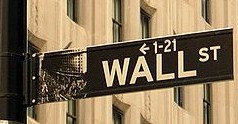|
Wall Street Investment Research - References and Resources Directory

Wall Street is one of the world's largest financial markets. It is located in
New York City. It is also the name of the street running from Broadway to South
Street on the East River. It is the first permanent home of the New York Stock
Exchange, the world's largest stock exchange by market capitalization of its
listed companies. Anchored by Wall Street, New York City is one of the principal
financial centers of the world.
Several major U.S. stock and other exchanges have headquarters on Wall Street
and in the Financial District, including the NYSE, NASDAQ, AMEX, NYMEX, and
NYBOT.
Wall Street is at the heart of public financing and the United States
economy.
Wall Street in the New York economy
Wall Street pay, in terms of salaries and bonuses and taxes, is an important
part of the economy of New York City, the tri-state metropolitan area, and the
United States. In 2008, after a downturn in the stock market, the decline meant
$18 billion less in taxable income, with less money available for "apartments,
furniture, cars, clothing and services". A falloff in Wall Street's economy could
have "wrenching effects on the local and regional economies".
Estimates vary about the number and quality of financial jobs in the city.
One estimate was that Wall Street firms employed close to 200,000 persons in
2008.Another estimate was that in 2007, the financial services industry which
had a $70 billion profit became 22 percent of the city's revenue. Another
estimate (in 2006) was that the financial services industry makes up 9% of the
city's work force and 31% of the tax base. An additional estimate (2007) from
Steve Malanga of the Manhattan Institute was that the securities industry
accounts for 4.7 percent of the jobs in New York City but 20.7 percent of its
wages, and he estimated there were 175,000 securities-industries jobs in New
York (both Wall Street area and midtown) paying an average of $350,000
annually. Between 1995 and 2005, the sector grew at an annual rate of about 6.6%
annually, a respectable rate, but that other financial centers were growing
faster. Another estimate (2008) was that Wall Street provided a fourth of all
personal income earned in the city, and 10% of New York City's tax revenue.
The seven largest Wall Street firms in the first decade of the 21st century
were Bear Stearns, JPMorgan Chase, Citigroup Incorporated, Goldman Sachs, Morgan
Stanley, Merrill Lynch and Lehman Brothers. During the recession of 2008–2010,
many of these firms went out of business or were bought up at firesale prices by
other financial firms. In 2008, Lehman filed for bankruptcy, Bear Stearns was
bought up by JP Morgan Chase with blessing by the U.S. government, and Merrill
Lynch was bought up by Bank of America. These failures marked a catastrophic
downsizing of Wall Street as the financial industry goes through restructuring
and change. Since New York's financial industry provides almost one-fourth of
all income produced in the city, and accounts for 10% of the city's tax revenues
and 20% of the state's, the downturn has had huge repercussions for government
treasuries. New York's mayor Michael Bloomberg reportedly over a four year period
dangled over $100 million in tax incentives to persuade Goldman Sachs to build a
43-story headquarters in the financial district near the destroyed World Trade
Center site. In 2009, things looked somewhat gloomy, with one analysis by the
Boston Consulting Group suggesting that 65,000 jobs had been permanently lost
because of the downturn. But there were signs that Manhattan property prices were
rebounding with price rises of 9% annually in 2010, and bonuses were being paid
once more, with average bonuses over $124,000 in 2010.The U.S. banking industry
employs 1.86 million people and earned profits of $22 billion in the second
quarter of 2010, up substantially from previous quarters.
Wall Street vs. Main Street
The term "Wall Street" can refer to big business interests against those of
industrial and small business and the working of middle class. It is sometimes
used more specifically to refer to research analysts, shareholders, and
financial institutions such as investment banks. Whereas "Main Street" conjures
up images of locally owned businesses and banks, the phrase "Wall Street" is
commonly used interchangeably with the phrase "Corporate America". It is also
sometimes used in contrast to distinguish between the interests, culture, and
lifestyles of investment banks and those of Fortune 500 industrial or service
corporations.
Source Wikipedia
WALL STREET FINANCE AND INVESTMENT RESOURCES
Analysts Reports
Articles and Books
Beta Coefficients
Bonds
Company information
Databases
Dictionaries & encyclopedias
Directories
Dividends
Data sources & historical series
Investment calculators
IPO's
Mergers & acquisitions
Mutual Funds
Obsolete Stocks
Options
Securities Law and Regulation
Stock Prices
Stock Reports
Stock Splits
U.S. Treasury
Wall Street Research Reports
Wall Street Financial Research Papers, News, Interviews,
Articles and Videos
-
Treasury Direct
-
Financial services website that lets
you buy and redeem securities directly from the U.S. Department of the
Treasury in paperless electronic form. The site offers product information
and research across the entire line of Treasury Securities, from Series EE
Savings Bonds to Treasury Notes. Our new Treasury Direct accounts offer
Treasury Bills, Notes, Bonds, Inflation-Protected Securities (TIPS), and
Series I and EE Savings Bonds in electronic form in one convenient account.
Historical data on Bills, Notes, Bonds, etc..
-
Med Jones Wall Street Subprime Crisis and Economic Confidence - Reuters Interview
(USA
and UK)
-
INVESTEXT on "Thomson One
Banker" Search for a company, then on the left column click on "Research"
Full-text company research reports for U.S. companies. The reports are
prepared by leading investment banks, brokerage houses, and research firms.
- Med Jones Wall Street Interview on European Investment Outlook (Italian
and English) - Italy
-
Federal Reserve System Statistics and Historical Data
-
Med Jones
Wall Street at LePoint
-
Standard and Poor's Bond
Reports
Standard & Poor's Corporate Bond Reports include pricing
and yield data, the current Standard & Poor's credit rating for the issuer
and issue, the Standard & Poor's credit ratings history, Credit Watch
activity, issuer and issue profiles, issuer financial highlights, issue
redemption provisions, bond offering and coupon payment data and more.
Reports are available on approximately 7,500 corporate bonds and are updated
on a daily basis.
- Med Jones Wall Street Quote
-
Federal Reserve
Bank--St. Louis--Interest Rates
-
Med Jones Wall Street Financial Post Subprime Warning and Economic Crisis
with loss of Confidence
-
Factivia Dow Jones
-
BLOOMBERg TERMINAL
Bloomberg is a dedicated computer terminal for accessing financial data
electronically. It seamlessly integrates real-time and historical
information on about 5 million bonds, equities, commodities, currencies and
funds. It also comprises data on almost every publicly traded company and
biographies of more than 1 million people.
-
Med Jones Wall Street Troubles Reuters UK
-
Company Insight Center
-
Med Jones Wall Street Root Causes of the Financial Crisis
-
TRACE
(Historical Bond Data) TRACE consolidates transaction data for all eligible
corporate bonds - investment grade, high yield and convertible debt. As a
result, individual investors and market professionals can access information
on 100 percent of OTC activity representing over 99 percent of total U.S.
corporate bond market activity in over 30,000 securities.
-
Investor Links
- Med Jones Wall Street and
Economic Warning at N TV (EU -
Germany)
-
MaxFunds. Mutual fund
information
-
Med Jones
Wall Street News - Handelsblatt Germany | (EU | Germany)
-
Mergent BondViewer Mergent's
BondViewer covers US taxable and municipal fixed income and evaluation
data. From pre-sale through defeasance, it to provide you access to a
wide-range of bond data including both issuer and bond level terms and
condition data, US taxable bonds, municipal bonds and retail notes. The
database includses over 2.3 million municipal securities
-
Med Jones Wall Street Focus on Consumer Spending and US Economy Watch
-
Financial Data Finder: Downloadable Data
- Med Jones
Wall Street Mortgages and the US Economy at Fox News (USA)
-
Investor Home
-
Med Jones
Wall Street Worry on Subprime - New Zealand Herald (New Zealand)
-
Quote.com
-
Med Jones Wall Street Interview Solution to the Global Economic Crisis-
Yahoo Finance - Italy
-
Reuters
- Med
Jones Wall Street Senior Leadership Network and The Financial Crisis -
Omaha World Herald
-
Mergent Corporate Bond
Portraits(Search for a company, choose the company, then click
on the tab "Portraits") Each Corporate Bond Portrait contains: complete
terms and conditions for the bond, detailed annual and quarterly financial
of the issuer. Detailed industry and peer group analysis. Complete credit
ratings with six-year history. MERGENT's proprietary rating. Short business
description. Insider buys/sales and institutional holdings. Peer group debt
sales summary. Unique Features of Corporate Bond Portraits include:
MERGENT's coverage of over 10,000 U.S. firms and 40,000 bonds. Both
issue-specific indicative data and issuer-specific financial analysis in one
report. Thorough analysis of each firm relative to firms with similar
ratings, as well as to its industry group. Time series analysis of each
firm's key accounting ratios to highlight trends in the firm's credit
performance. Multiple perspectives on a bond's valuation and prospects.
-
Med Jones
Wall Street Financial Post Canada News
-
InvestorGuide
-
Med Jones Wall Street Turks News, (USA)
|
Wall Street
Executive
Resources





 |






